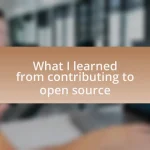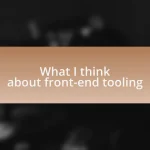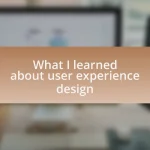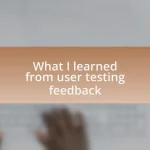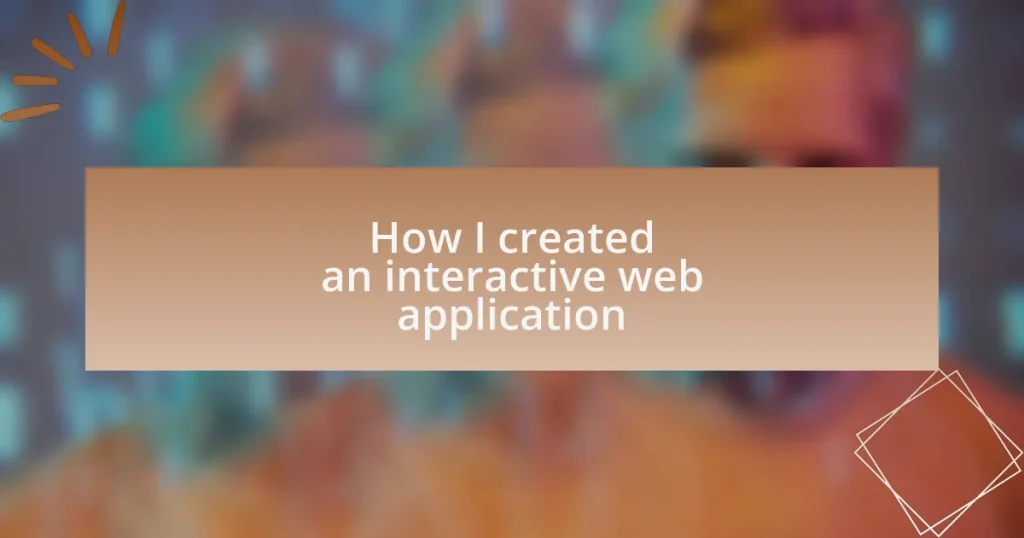Key takeaways:
- Interactive web applications enhance user engagement through immediate feedback and meaningful interactions.
- Personal programming projects allow for hands-on learning and creative expression, reflecting individual passions.
- Choosing project ideas that stem from personal challenges can spark creativity and maintain motivation.
- Planning, flexibility, and appropriate tool selection are crucial for successful web application development.
Author: Clara Whitmore
Bio: Clara Whitmore is an acclaimed author known for her poignant explorations of human connection and resilience. With a degree in Literature from the University of California, Berkeley, Clara’s writing weaves rich narratives that resonate with readers across diverse backgrounds. Her debut novel, “Echoes of the Past,” received critical acclaim and was a finalist for the National Book Award. When she isn’t writing, Clara enjoys hiking in the Sierra Nevada and hosting book clubs in her charming hometown of Ashland, Oregon. Her latest work, “Threads of Tomorrow,” is set to release in 2024.
Understanding interactive web applications
Interactive web applications have transformed the way we engage with the digital world. I remember the first time I used a web app that responded immediately to my input; it felt almost magical. That seamless interaction made me realize how important immediate feedback is in keeping users engaged.
At its core, an interactive web application allows users to actively participate rather than passively consume content. Think about your own experiences—when was the last time you left a website because you couldn’t interact in a meaningful way? I’ve left countless sites that felt stagnant, only to return to those that invited me to explore further.
Creating these applications requires not just technical knowledge but also an emotional connection with user experience. I’ve experienced moments of frustration and excitement as I tried to figure out how to make my app responsive and engaging. Each challenge taught me that an interactive web application isn’t just about flashy features; it’s about crafting an experience that resonates with users on a deeper level.
Importance of personal programming projects
Engaging in personal programming projects is crucial for growth and skill enhancement. I’ve often found that the best way to solidify my understanding of programming concepts is through hands-on experience. For instance, tackling a unique problem in my project often leads to deeper insights that theory alone can’t provide.
These projects serve as a canvas for experimentation, allowing me to explore new technologies and frameworks without the constraints of formal deadlines. I remember the exhilaration I felt when I tried a cutting-edge JavaScript library in my app, and it worked perfectly. It was a moment of victory that fueled my enthusiasm for learning even more.
Moreover, personal projects reflect my passions and interests, offering a sense of agency in my work. I often ask myself, “What am I truly excited about building?” The answer drives my creativity and keeps me motivated. Other projects might feel like chores, but when it’s personal, every line of code becomes an expression of who I am as a programmer.
Choosing the right project idea
Choosing the right project idea is often a blend of passion and practicality. I remember when I decided to create a web application for tracking my fitness journey. It was not just about coding; it was an endeavor rooted in something I genuinely cared about, which made it rewarding and engaging.
Reflecting on my experiences, I’ve learned that the best project ideas often stem from personal challenges or interests. Ask yourself, “What problem do I face that could be solved through programming?” For me, turning a need into a project often sparks creativity and keeps the momentum going when things get tough.
It’s also important to consider the scope of the idea. Starting with something too ambitious can lead to frustration and burnout. I initially aimed for a complex app but realized scaling it back allowed me to produce a functional version faster, which in turn motivated me to iterate and improve over time. Balancing ambition with realism can significantly enhance the project experience.
Planning your web application
When it comes to planning your web application, I find it crucial to outline your goals clearly. I remember sitting down with a notebook, jotting down all the features I envisioned for my fitness tracker. It’s amazing how visualizing your ideas can help prioritize what’s truly important. Have you ever felt overwhelmed by too many options? That’s where a well-structured outline can save you from confusion.
As I delved deeper into my planning phase, I realized the importance of user experience (UX). I often ask myself, “How will users interact with my app?” This question guided me as I sketched out wireframes, ensuring that the navigation would be intuitive. Seeing these ideas take shape on paper made the project feel tangible, fueling my excitement to start coding.
Another critical aspect I learned is to embrace flexibility in your plan. Early on, I thought I had everything figured out, but as I built, I encountered various technical challenges that required adjustments. How often do we stick to a plan, even when it becomes evident that a shift is needed? I discovered that tapping into my ability to adapt not only salvaged my enthusiasm but also led to unexpected improvements in the final product.
Selecting tools and technologies
Selecting the right tools and technologies was an exhilarating yet daunting process for me. I remember spending hours researching programming languages and frameworks, weighing their pros and cons. Choosing JavaScript and React felt like a no-brainer because of their extensive community support and versatility. Have you ever experienced analysis paralysis? That’s where I found myself, but narrowing my focus on what truly aligned with my project goals made the decision clearer.
As I progressed, I discovered how crucial it is to select tools that match your skill level. I initially attempted to integrate complex libraries that were beyond my expertise, which led to frustration and missed deadlines. But when I scaled back and chose simpler technologies that I could confidently manipulate, my productivity soared. This is where I learned that the simplest solutions often yield the best outcomes.
I also found that experimenting with different technologies can be incredibly beneficial. For instance, I tested various databases and settled on Firebase for its ease of use and real-time capabilities. It’s fascinating how diving into the unknown can lead to discoveries that enhance your project. Do you think you know all the options available? You might be surprised at what you can learn by just trying out new tools!






